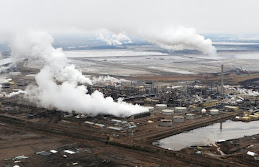The Enbridge Northern Gate PipelinesA Disastrous Environmental Projectand Detrimental to First Nation People
Mahin Milani
Mahin Milani

The Enbridge Northern Gate Project is a 5.5 billion proposal to build two pipelines (1.170 Kilometres) from Alberta’s tar sands (which consist of a thick, tarry substance) to British Colombia’s coast at Kitimat. The diluted bitumen would then be transported to refineries in USA, Asia or elsewhere by super tankers. This project proposed by The Enbridge Inc. is not tenable because it has disastrous environmental effects, it impacts the First Nations people in an extremely negative way and lastly it is not an effective economic decision.
 Canadian tar sands are amongst the dirtiest oils in the world and their quality exceeds the
Canadian tar sands are amongst the dirtiest oils in the world and their quality exceeds the
safe limit that scientists have suggested for human health. On 23 February 2012, European Union Delegates voted on new regulations on crude oil imports and have rated Alberta’s tar sand oil with 23 per cent more points than regular crude and in result it failed to pass as a sustainable oil to import into European countries (Colangelo Par. 2). In USA, President Barak Obama refused delivering Alberta’s oil sands to the States “after Nebraska farmers and environmentalists raised concerns” (McClelland Par. 2). The increase of the refineries to process sand oil is also a problem as the “synthetic heavy crude produced from tar sands is laden with more toxics than conventional oil” (“The Spread of Oil Sands” Sec.2, Par.1). On 25 July, 2010, 60 percent of people in Kalamazoo River in Michigan area were affected by four million liters of the Enbridge Pipelines diluted bitumen spilled into the river which emitted benzene and other chemicals (Swift, et al. 7).
It is clear from these studies that Canadian tar sand oil is extremely dangerous. However, that in itself is not an argument against the construction of the pipelines. But there is a high risk of spilling involved in the operation presented by the Enbridge, because the pipelines would traverse dangerous areas (which also turn out to be rich in fish bearing habitat). A tank farm at Kitimat would transfer the oil into large super tankers that cross 185 kilometres inside the ocean to reach unpredictably hazardous straits and entrances. “The route poses many navigational challenges for large vessels, even under ideal conditions” (Swift, et al. 3), and as large oil tankers don’t have the experience to navigate inside central and northern waters of British Columbia, the risk of spillage is that more higher. Moreover, the steam injection process required to liquefy and dilute the tarry oil sand for a better flow in the pipelines, creates a higher probability of spills. This process creates friction and promotes erosion because the diluted bitumen contains 15 to 20 times more organic acid and 5 to 10 times more sulphur than traditional crude, releasing three times more greenhouse gas emission, and the pipelines carry a significant amount of quartz, silicates, and “sediments composed of pyrite and aluminosilicates per day” (Swift, et al. 6). Thus it appears that the project proposed by Enbridge presents a real risk of spillage of the dangerous tar sand oil.
Not only oil spill is inevitable, but the cleaning of the spills also presents extreme difficulties, because there are inadequate measures and possibilities to find the source of the leak and to clean up the areas contaminated with diluted bitumen. As past accidents have shown, this is no easy feat. For example “the 3 million litre Enbridge spill in Michigan required more than 2000 personnel, over 45 kilometres of boom, 175 heavy spill response trucks, 43 boats, and 48 oil skimmers” (Swift, et al. 8). 21 leaks in USA and 14 in Canada (the largest about 80,000 litres in May of 2011), were reported in the first year of operation of TransCanada’s Keystone pipeline (Swift, et al. 8 col. 2). The leak detection systems have failed in many cases and it is not clear how long the pipelines have been leaking. “Significant geotechnical difficulties” and “unstable parts” along pipelines trajectory is another imperative issue that broaches oil spilling is inevitable and the habitat of people and fish is in rigorous risk. Landslides, fire, rain storm, flood, avalanches and explosion are hazards which require vigilant conducted visual assessments, and past incidents indicate that Enbridge has had limited evaluation of some areas such as a pipe line in Symoetx where a landslide in 2002 “disrupted natural gas service to Kitimat, Terrace, and Prince Rupert and caused CAD$27.5 million“ to local economy (Swift, et al. 12). Consequently, delivering the dirtiest oil in the world by the Enbridge pipeline project, with an erosive diluting system and lack of adequate possibilities to find the leaking source and cleaning area would be a devastating decision for the environment and the health of persons involved.
The pipelines project also impacts the First Nations peoples in an extremely negative way. They strongly depend on nature, notably fishing, and strongly tied to cultural traditions. So if their lands and waters get contaminated by oil spills, their life style will be thoroughly and dramatically altered. In numerous gatherings, rallies, and in the first public Joint Review Panel hearing where 4300 people were registered to talk about The Northern Gateway Pipeline Project, First Nations peoples have opposed the project (”Northern Gateway Pipeline” Par.4). Samuel Robinson, a hereditary chief from Kitimat Village, voiced his opposition: "’The area is rich with seafood, halibut, cod, fur-bearing animals…It worries me that all this will be lost or destroyed when there is a spill…Experience knows it will happen’ " (“Hundreds Pack Northern” Sec. 2 Par.3).
First Nations Land claims and rights also might be violated by this project and would lead to social unrest. As Deborah Yedlin points out there is no agreement regarding land claims with British Columbian First Nations before the project could proceed (Yedlin 12), as Jackie Thomas of the Saik’uz First Nation declares: “’Our five nations hold more than 25 per cent of this proposed pipeline route in our territory, and we will never allow it to be built’” (Stoymenoff “Naomi Klein and” Par.6). Yedlin explains that the Crown would be responsible to see if First Nations rights and livelihood is affected. She remarks that in case of spillage “other places must be found where the traditional life can be pursued” (Yedlin 12). In other words aboriginal people might be forced to leave their ancestral land and go else where because of the pipeline project or resign to remain in an environment devastated by the pipelines.
Division and hostility between different First Nations could in addition occur as the Enbridge Inc. is trying to satisfy some of them by promising considerable guarantees. “Embridge is offering up a 10 per cent stake” (“B.C. First Nation” Sec.2 Par.10) to the aboriginal groups that are signed on with the Enbridge. Elmer Derrick, Gitxsan hereditary chief is expecting $7 million of net profit of the project due to an agreement with Enbridge. Janet Holder, the Enbridge executive in charge of Northern Gateway said other agreements have been endorsed even though the numbers couldn’t be revealed because of confidentiality clauses (“B.C. First Nation” Sec.2 Par.8 &10). On the contrary, many First Nations peoples have denied Embridges’s claim. The president of the Haida Nation Council, Guujaaw, denounced - in a letter to Vancouver Sun blog and QCI Observer - the Enbridge’s claims of engaging in “’relationship building’” with the coastal First Nations. Additionally, in an email sent to the Joint Review Panel dated Dec. 20 he wrote: "Enbridge has provided deliberately misleading and false information claiming that [it] has built relationships with the Haida." (Stoymenoff “Haida Nation Leader” Sec.2 Par.2). While 130 Nations across British Columbia have endorsed Save the Fraser Declaration vowing to protect unceded territories from the pipeline (“Haida Nation Leader” Par.5), the Enbridge’s offer to some First Nation leaders could create hostility and division between different nations.
Finally, the Pipelines Gateway Project is not an effective economic decision. The main argument for the claims that the project is creating jobs is invalid. If completed, pipe lines would provide 1150 full time jobs in Alberta and British Columbia (Northern Gateway Pipeline” Sec.1 Par.4). For 5.5 billion dollars investment in the project, this number of jobs is minimal. In addition, the pipelines which traverse 785 rivers and streams could shatter the commercial fishery and nature tourism which contributes up to a value of $550 million Canadian dollars (Swift, et al. 11). If Canada refined its row bitumen in Canadian refineries before exporting it, it would gain a great economic profit. By turning to foreign refineries, it is “foregoing an opportunity to add value to 365 million barrels a year” (Hume Par.9). Stephen Hume argues that “refining Infrastructure” would create more enduring benefit for Canadians and suggests that as Alberta’s economy is blooming, there are other regions with a lot of capacity for enhancing or building new refineries and creating long term jobs along with stimulating economy (Hume Par.4). Subsequently, it would be economically advantageous to transfer the crude oil to refineries inside the country, and to export the manufactured oil products with higher prices. If the environment is protected, salmon which is “a central component of the province’s ecology, culture, economy, and social fabric” (Swift, et al. 11) wouldn’t be drastically affected by the spill of Northern Gateway pipeline’s diluted bitumen, and It could continue to generate an important economy. Jobs could also be created in other more beneficial and healthier sectors such as local fish and agricultural domains, in healthy and organic food industries and so on. By creating local products we would generate increasingly more local jobs, we would have more control on the production quality, we would spend less for transporting the imported products and we would be less concerned about the global crises which hit time to time the world economy and degrade national security. By building local refineries and by creating local production possibilities, we would help generating more long-term jobs and a more secure economy.
This project is not acceptable because of its disastrous environmental effects, its extremely negative impacts on the First Nations peoples and its counter productive economic aspect. Therefore it is not in the interest of Canadians and one can only hope that the ongoing debates until 2013 will consider aboriginal peoples, environmentalist concerns, as well as the complex economic situation with sufficient details to make an appropriate decision.
Works Cited
“B.C. First Nation backs Northern Gateway pipeline”.
CBC News Dec. 2011 Web. 2 Dec 2011
http://www.fatnewspaper.com/b.c.-first-nation-backsnortherngatewaypipeline.1.27516.html
Colangelo, Jeremy. “EU oil sands vote ends in stalemate“.
The Brock Press. Feb. 27, 2012. Web. 28 Feb. 2012
http://www.brockpress.com/news/external-news/eu-oil-sands-vote-ends-in-stalemate-1.2799837
“Hundreds pack Northern Gateway pipeline hearing”.
CBC News. Jan 10, 2012. Web. 10 Jan 2012 Read 1745 comments1745
http://www.cbc.ca/news/canada/british-columbia/story/2012/01/10/bc-northern-gateway-enbridge-kitimat.html
Hume, Stephen. Keep jobs in Canada: Build refineries for oil sands
Vancouver Sun. Web. 30 Jan 2012
http://www.vancouversun.com/business/Keep+jobs+Canada+Build+refineries+oilsands/6072415/story.html#ixzz1mgFcmPh6
McClelland, Colin, and Jeremy Van Loon “Obama Has Left Door Open for Keystone”.
Bloomberg. Feb 2012. Web. 7 Feb. 2012
http://www.bloomberg.com/news/2012-02-07/obama-has-left-door-open-for-keystone-
Nikiforuk, Andrew. “Why Keystone Pipeline Will Weaken the US”.
The Thee. Web. 27 May 2011
http://thetyee.ca/Opinion/2011/05/27/KeystonePipeline/
“Northern Gateway pipeline hearings to start in B.C.”
The Canadian Press. Web. Jan 8, 2012
http://www.cbc.ca/news/politics/story/2012/01/08/bc-northern-gateway.html
Stoymenoff, Alexis. “Haida Nation leader outraged over ’libelous’ Enbridge documents”.
The Vancouver Observer. Web. 10 Jan 2010
http://www.vancouverobserver.com/sustainability/2012/01/10/haida-nation-leader-outraged-over-%E2%80%9Clibelous%E2%80%9D-enbridge-documents
Stoymenoff, Alexis. “Naomi Klein and First Nations leaders unite at anti-pipeline forum”.
The Vancouver Observer. Web. 2 Dec. 2011
http://www.vancouverobserver.com/sustainability/2011/12/02/naomi-klein-and-first-nations-leaders-unite-anti-pipeline-forum
Swift , Anthony, Nathan Lamphers, Susan Casey, lef Kowitz, Katie Terhume, and Danielle Droitxch. “Pipe line and Tanker problem”. Web. PDF. Nov. 2011
NRDC Natural Resources Defence Council
http://www.nrdc.org/international/files/PipelineandTankerTrouble.pdf
“The Spread of Oil Sands”. Dirty Oil Sand
http://dirtyoilsands.org/thedirt/article/the_spread_of_oil_sands
Yedlin, Deborah. ”Northern Gateway pipeline reveals risks of unsettled land claims”.
Calgary herald. Postmedia News. Web. 17 Feb. 2012
http://www.calgaryherald.com/business/Nobel+laureates+write+anti+oilsands+letter/6167539/story.html#ixzz1mgGHULXq
 Canadian tar sands are amongst the dirtiest oils in the world and their quality exceeds the
Canadian tar sands are amongst the dirtiest oils in the world and their quality exceeds thesafe limit that scientists have suggested for human health. On 23 February 2012, European Union Delegates voted on new regulations on crude oil imports and have rated Alberta’s tar sand oil with 23 per cent more points than regular crude and in result it failed to pass as a sustainable oil to import into European countries (Colangelo Par. 2). In USA, President Barak Obama refused delivering Alberta’s oil sands to the States “after Nebraska farmers and environmentalists raised concerns” (McClelland Par. 2). The increase of the refineries to process sand oil is also a problem as the “synthetic heavy crude produced from tar sands is laden with more toxics than conventional oil” (“The Spread of Oil Sands” Sec.2, Par.1). On 25 July, 2010, 60 percent of people in Kalamazoo River in Michigan area were affected by four million liters of the Enbridge Pipelines diluted bitumen spilled into the river which emitted benzene and other chemicals (Swift, et al. 7).
It is clear from these studies that Canadian tar sand oil is extremely dangerous. However, that in itself is not an argument against the construction of the pipelines. But there is a high risk of spilling involved in the operation presented by the Enbridge, because the pipelines would traverse dangerous areas (which also turn out to be rich in fish bearing habitat). A tank farm at Kitimat would transfer the oil into large super tankers that cross 185 kilometres inside the ocean to reach unpredictably hazardous straits and entrances. “The route poses many navigational challenges for large vessels, even under ideal conditions” (Swift, et al. 3), and as large oil tankers don’t have the experience to navigate inside central and northern waters of British Columbia, the risk of spillage is that more higher. Moreover, the steam injection process required to liquefy and dilute the tarry oil sand for a better flow in the pipelines, creates a higher probability of spills. This process creates friction and promotes erosion because the diluted bitumen contains 15 to 20 times more organic acid and 5 to 10 times more sulphur than traditional crude, releasing three times more greenhouse gas emission, and the pipelines carry a significant amount of quartz, silicates, and “sediments composed of pyrite and aluminosilicates per day” (Swift, et al. 6). Thus it appears that the project proposed by Enbridge presents a real risk of spillage of the dangerous tar sand oil.
Not only oil spill is inevitable, but the cleaning of the spills also presents extreme difficulties, because there are inadequate measures and possibilities to find the source of the leak and to clean up the areas contaminated with diluted bitumen. As past accidents have shown, this is no easy feat. For example “the 3 million litre Enbridge spill in Michigan required more than 2000 personnel, over 45 kilometres of boom, 175 heavy spill response trucks, 43 boats, and 48 oil skimmers” (Swift, et al. 8). 21 leaks in USA and 14 in Canada (the largest about 80,000 litres in May of 2011), were reported in the first year of operation of TransCanada’s Keystone pipeline (Swift, et al. 8 col. 2). The leak detection systems have failed in many cases and it is not clear how long the pipelines have been leaking. “Significant geotechnical difficulties” and “unstable parts” along pipelines trajectory is another imperative issue that broaches oil spilling is inevitable and the habitat of people and fish is in rigorous risk. Landslides, fire, rain storm, flood, avalanches and explosion are hazards which require vigilant conducted visual assessments, and past incidents indicate that Enbridge has had limited evaluation of some areas such as a pipe line in Symoetx where a landslide in 2002 “disrupted natural gas service to Kitimat, Terrace, and Prince Rupert and caused CAD$27.5 million“ to local economy (Swift, et al. 12). Consequently, delivering the dirtiest oil in the world by the Enbridge pipeline project, with an erosive diluting system and lack of adequate possibilities to find the leaking source and cleaning area would be a devastating decision for the environment and the health of persons involved.
The pipelines project also impacts the First Nations peoples in an extremely negative way. They strongly depend on nature, notably fishing, and strongly tied to cultural traditions. So if their lands and waters get contaminated by oil spills, their life style will be thoroughly and dramatically altered. In numerous gatherings, rallies, and in the first public Joint Review Panel hearing where 4300 people were registered to talk about The Northern Gateway Pipeline Project, First Nations peoples have opposed the project (”Northern Gateway Pipeline” Par.4). Samuel Robinson, a hereditary chief from Kitimat Village, voiced his opposition: "’The area is rich with seafood, halibut, cod, fur-bearing animals…It worries me that all this will be lost or destroyed when there is a spill…Experience knows it will happen’ " (“Hundreds Pack Northern” Sec. 2 Par.3).
First Nations Land claims and rights also might be violated by this project and would lead to social unrest. As Deborah Yedlin points out there is no agreement regarding land claims with British Columbian First Nations before the project could proceed (Yedlin 12), as Jackie Thomas of the Saik’uz First Nation declares: “’Our five nations hold more than 25 per cent of this proposed pipeline route in our territory, and we will never allow it to be built’” (Stoymenoff “Naomi Klein and” Par.6). Yedlin explains that the Crown would be responsible to see if First Nations rights and livelihood is affected. She remarks that in case of spillage “other places must be found where the traditional life can be pursued” (Yedlin 12). In other words aboriginal people might be forced to leave their ancestral land and go else where because of the pipeline project or resign to remain in an environment devastated by the pipelines.
Division and hostility between different First Nations could in addition occur as the Enbridge Inc. is trying to satisfy some of them by promising considerable guarantees. “Embridge is offering up a 10 per cent stake” (“B.C. First Nation” Sec.2 Par.10) to the aboriginal groups that are signed on with the Enbridge. Elmer Derrick, Gitxsan hereditary chief is expecting $7 million of net profit of the project due to an agreement with Enbridge. Janet Holder, the Enbridge executive in charge of Northern Gateway said other agreements have been endorsed even though the numbers couldn’t be revealed because of confidentiality clauses (“B.C. First Nation” Sec.2 Par.8 &10). On the contrary, many First Nations peoples have denied Embridges’s claim. The president of the Haida Nation Council, Guujaaw, denounced - in a letter to Vancouver Sun blog and QCI Observer - the Enbridge’s claims of engaging in “’relationship building’” with the coastal First Nations. Additionally, in an email sent to the Joint Review Panel dated Dec. 20 he wrote: "Enbridge has provided deliberately misleading and false information claiming that [it] has built relationships with the Haida." (Stoymenoff “Haida Nation Leader” Sec.2 Par.2). While 130 Nations across British Columbia have endorsed Save the Fraser Declaration vowing to protect unceded territories from the pipeline (“Haida Nation Leader” Par.5), the Enbridge’s offer to some First Nation leaders could create hostility and division between different nations.
Finally, the Pipelines Gateway Project is not an effective economic decision. The main argument for the claims that the project is creating jobs is invalid. If completed, pipe lines would provide 1150 full time jobs in Alberta and British Columbia (Northern Gateway Pipeline” Sec.1 Par.4). For 5.5 billion dollars investment in the project, this number of jobs is minimal. In addition, the pipelines which traverse 785 rivers and streams could shatter the commercial fishery and nature tourism which contributes up to a value of $550 million Canadian dollars (Swift, et al. 11). If Canada refined its row bitumen in Canadian refineries before exporting it, it would gain a great economic profit. By turning to foreign refineries, it is “foregoing an opportunity to add value to 365 million barrels a year” (Hume Par.9). Stephen Hume argues that “refining Infrastructure” would create more enduring benefit for Canadians and suggests that as Alberta’s economy is blooming, there are other regions with a lot of capacity for enhancing or building new refineries and creating long term jobs along with stimulating economy (Hume Par.4). Subsequently, it would be economically advantageous to transfer the crude oil to refineries inside the country, and to export the manufactured oil products with higher prices. If the environment is protected, salmon which is “a central component of the province’s ecology, culture, economy, and social fabric” (Swift, et al. 11) wouldn’t be drastically affected by the spill of Northern Gateway pipeline’s diluted bitumen, and It could continue to generate an important economy. Jobs could also be created in other more beneficial and healthier sectors such as local fish and agricultural domains, in healthy and organic food industries and so on. By creating local products we would generate increasingly more local jobs, we would have more control on the production quality, we would spend less for transporting the imported products and we would be less concerned about the global crises which hit time to time the world economy and degrade national security. By building local refineries and by creating local production possibilities, we would help generating more long-term jobs and a more secure economy.
This project is not acceptable because of its disastrous environmental effects, its extremely negative impacts on the First Nations peoples and its counter productive economic aspect. Therefore it is not in the interest of Canadians and one can only hope that the ongoing debates until 2013 will consider aboriginal peoples, environmentalist concerns, as well as the complex economic situation with sufficient details to make an appropriate decision.
Works Cited
“B.C. First Nation backs Northern Gateway pipeline”.
CBC News Dec. 2011 Web. 2 Dec 2011
http://www.fatnewspaper.com/b.c.-first-nation-backsnortherngatewaypipeline.1.27516.html
Colangelo, Jeremy. “EU oil sands vote ends in stalemate“.
The Brock Press. Feb. 27, 2012. Web. 28 Feb. 2012
http://www.brockpress.com/news/external-news/eu-oil-sands-vote-ends-in-stalemate-1.2799837
“Hundreds pack Northern Gateway pipeline hearing”.
CBC News. Jan 10, 2012. Web. 10 Jan 2012 Read 1745 comments1745
http://www.cbc.ca/news/canada/british-columbia/story/2012/01/10/bc-northern-gateway-enbridge-kitimat.html
Hume, Stephen. Keep jobs in Canada: Build refineries for oil sands
Vancouver Sun. Web. 30 Jan 2012
http://www.vancouversun.com/business/Keep+jobs+Canada+Build+refineries+oilsands/6072415/story.html#ixzz1mgFcmPh6
McClelland, Colin, and Jeremy Van Loon “Obama Has Left Door Open for Keystone”.
Bloomberg. Feb 2012. Web. 7 Feb. 2012
http://www.bloomberg.com/news/2012-02-07/obama-has-left-door-open-for-keystone-
Nikiforuk, Andrew. “Why Keystone Pipeline Will Weaken the US”.
The Thee. Web. 27 May 2011
http://thetyee.ca/Opinion/2011/05/27/KeystonePipeline/
“Northern Gateway pipeline hearings to start in B.C.”
The Canadian Press. Web. Jan 8, 2012
http://www.cbc.ca/news/politics/story/2012/01/08/bc-northern-gateway.html
Stoymenoff, Alexis. “Haida Nation leader outraged over ’libelous’ Enbridge documents”.
The Vancouver Observer. Web. 10 Jan 2010
http://www.vancouverobserver.com/sustainability/2012/01/10/haida-nation-leader-outraged-over-%E2%80%9Clibelous%E2%80%9D-enbridge-documents
Stoymenoff, Alexis. “Naomi Klein and First Nations leaders unite at anti-pipeline forum”.
The Vancouver Observer. Web. 2 Dec. 2011
http://www.vancouverobserver.com/sustainability/2011/12/02/naomi-klein-and-first-nations-leaders-unite-anti-pipeline-forum
Swift , Anthony, Nathan Lamphers, Susan Casey, lef Kowitz, Katie Terhume, and Danielle Droitxch. “Pipe line and Tanker problem”. Web. PDF. Nov. 2011
NRDC Natural Resources Defence Council
http://www.nrdc.org/international/files/PipelineandTankerTrouble.pdf
“The Spread of Oil Sands”. Dirty Oil Sand
http://dirtyoilsands.org/thedirt/article/the_spread_of_oil_sands
Yedlin, Deborah. ”Northern Gateway pipeline reveals risks of unsettled land claims”.
Calgary herald. Postmedia News. Web. 17 Feb. 2012
http://www.calgaryherald.com/business/Nobel+laureates+write+anti+oilsands+letter/6167539/story.html#ixzz1mgGHULXq

























